story and photos by Kayte Deioma
On a rainy day in Dusseldorf, you could take the kids to the Aquazoo, but if you’re this close to the Neander Valley, it’s worth taking a half hour detour out of town to the Neanderthal Museum near Mettman, where the original Neanderthal Man was discovered in 1856.
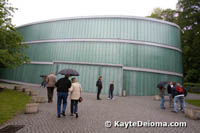 A couple quarrymen found the bones in a cave where they were mining limestone. After the most obvious human remains were removed, the digging continued and the site was buried under tons of gravel, its exact location forgotten. The Neanderthal bones made their way to the Rhine Province Museum in Bonn in 1877, but in 1937 a small Pre-History Museum was opened near the location of the original discovery. It went through various incarnations until a brand new building was opened in 1996 on a nearby site.
A couple quarrymen found the bones in a cave where they were mining limestone. After the most obvious human remains were removed, the digging continued and the site was buried under tons of gravel, its exact location forgotten. The Neanderthal bones made their way to the Rhine Province Museum in Bonn in 1877, but in 1937 a small Pre-History Museum was opened near the location of the original discovery. It went through various incarnations until a brand new building was opened in 1996 on a nearby site.
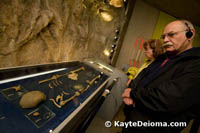 In 1997, archaeologists once again uncovered the original site. In 1997 and 2000 they recovered more bone fragments that matched the 1856 male skeleton, as well as additional remains of a woman and child. These original artifacts, along with replicas of the 1856 discoveries, are on display in the museum.
In 1997, archaeologists once again uncovered the original site. In 1997 and 2000 they recovered more bone fragments that matched the 1856 male skeleton, as well as additional remains of a woman and child. These original artifacts, along with replicas of the 1856 discoveries, are on display in the museum.
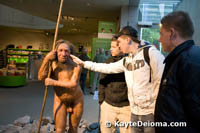 For its 10-year anniversary in 2006, the museum’s permanent exhibit was completely redone, using state-of-the-art technology to create the most accurate depictions yet of what Neanderthal man, woman and child most likely looked like and how they lived.
For its 10-year anniversary in 2006, the museum’s permanent exhibit was completely redone, using state-of-the-art technology to create the most accurate depictions yet of what Neanderthal man, woman and child most likely looked like and how they lived.
Neanderthal Man is not the only focus of the museum. The oval glass building in the woods houses the history of man’s evolution from 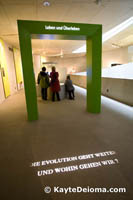 4 million years ago in Africa through today. You proceed from the lower level up a spiraling ramp through time. Themed exhibits includeLiving and Surviving, Tools and Knowledge, Myths and Religion, Nutrition and Environment, and Communication and Society.
4 million years ago in Africa through today. You proceed from the lower level up a spiraling ramp through time. Themed exhibits includeLiving and Surviving, Tools and Knowledge, Myths and Religion, Nutrition and Environment, and Communication and Society.
Although the whole timeline is covered, you actually start with the Neanderthal discoveries on the first level. Original bone fragments are laid out into the Neanderthal Man’s skeleton. Life 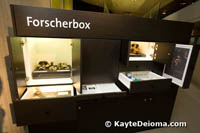 size models of Neanderthal men and women wouldn’t stand out too much in a crowd of modern-day humans.
size models of Neanderthal men and women wouldn’t stand out too much in a crowd of modern-day humans.
Big black Forscherboxes (research boxes) provide lots of compartments and drawers for curious visitors to open, revealing more artifacts, documents and research tools of archaeologists and forensic anthropologists. On the back side of each Forscherbox, computer touch screens provide an additional opportunity for further investigation on the subject, if you happen to speak German.
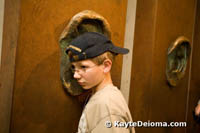 An audio exhibit of giant ears challenges the listener to imagine what cold or a cloud sounds like. To recreate the sensation of being in a grotto, you can stick your head up inside a cave-simulator suspended from the ceiling and look at cave
An audio exhibit of giant ears challenges the listener to imagine what cold or a cloud sounds like. To recreate the sensation of being in a grotto, you can stick your head up inside a cave-simulator suspended from the ceiling and look at cave 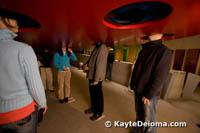 paintings projected on the walls. Kids will be tempted to climb up inside the cave-simulator, but don’t let them. The whole thing is hanging on a few screws and isn’t designed to hold weight.
paintings projected on the walls. Kids will be tempted to climb up inside the cave-simulator, but don’t let them. The whole thing is hanging on a few screws and isn’t designed to hold weight.
Comparisons of Neanderthal man’s bones with modern man’s bones, shows that he was physically stronger than his modern-day counterpart. A side-by-side presentation of our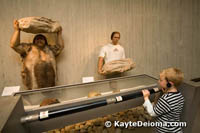 fur-clad ancestor with an Adidas-adorned 21st century German illustrates the relative strength of the two.
fur-clad ancestor with an Adidas-adorned 21st century German illustrates the relative strength of the two.
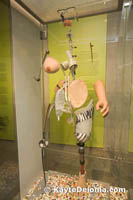 On the upper level is an interesting technology timeline. It shows the progression of technology from a fire flint to a Bic lighter; from a basic bore to a power drill, from a primitive needle and thread to a sewing machine. You can also see the present and future of human evolution with prosthetic limbs and other mechanical replacement parts for the body in use today.
On the upper level is an interesting technology timeline. It shows the progression of technology from a fire flint to a Bic lighter; from a basic bore to a power drill, from a primitive needle and thread to a sewing machine. You can also see the present and future of human evolution with prosthetic limbs and other mechanical replacement parts for the body in use today.
If it’s not raining too hard, or if you brought along your rain<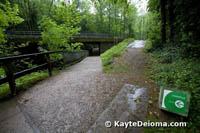 poncho and umbrella, like I did, you can visit the outdoor exhibits. In 2002, three trails were officially added to the museum presentation. The first, marked by green cubes, is theDiscovery Site. It is the shortest trail, just under a quarter mile from the museum. It is the only one on the same side of the street, heading to the right out the front door. The paved trail takes you along the Duessel River to the spot where the bones were found in 1856 and again in 1997 and 2000.
poncho and umbrella, like I did, you can visit the outdoor exhibits. In 2002, three trails were officially added to the museum presentation. The first, marked by green cubes, is theDiscovery Site. It is the shortest trail, just under a quarter mile from the museum. It is the only one on the same side of the street, heading to the right out the front door. The paved trail takes you along the Duessel River to the spot where the bones were found in 1856 and again in 1997 and 2000.
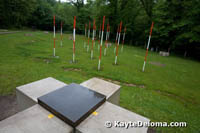 The cave has long since been reduced to quarry dust, and the site on the bank of the river has been replanted with grass and trees, although quarry work continues just over the hill. The Discovery Site (Fundstelle) is marked with red poles and surrounded by concrete crosses with text panels in the middle and plugs for your audio guide. I didn’t realize the audio trail continued outdoors, so I had already turned mine in, but I don’t think I would have wanted to plug in to a wet outlet anyway. The Discovery Site is a limited access area included with museum admission.
The cave has long since been reduced to quarry dust, and the site on the bank of the river has been replanted with grass and trees, although quarry work continues just over the hill. The Discovery Site (Fundstelle) is marked with red poles and surrounded by concrete crosses with text panels in the middle and plugs for your audio guide. I didn’t realize the audio trail continued outdoors, so I had already turned mine in, but I don’t think I would have wanted to plug in to a wet outlet anyway. The Discovery Site is a limited access area included with museum admission.
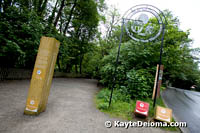 Across the street from the museum, two additional trails are marked out with red and yellow cubes. The yellow cubes mark the Menschenspuren (Human Traces) Trail, which leads to a series of sculptures on prehistoric themes by international artists. At the far end of this loop trail is the Game Reserve, with animals such as brumbies, wisents and aurochs that have been bred to be a close approximation of their ice age counterparts. It is recommended that you allow at least 90 minutes to complete the loop trail. The Human Traces Trail and Game Reserve are open access areas that do not require museum admission and are not restricted to museum hours.
Across the street from the museum, two additional trails are marked out with red and yellow cubes. The yellow cubes mark the Menschenspuren (Human Traces) Trail, which leads to a series of sculptures on prehistoric themes by international artists. At the far end of this loop trail is the Game Reserve, with animals such as brumbies, wisents and aurochs that have been bred to be a close approximation of their ice age counterparts. It is recommended that you allow at least 90 minutes to complete the loop trail. The Human Traces Trail and Game Reserve are open access areas that do not require museum admission and are not restricted to museum hours.
The red cubes lead to the Steinzeit Werkstatt (Stone Age Workshop), also along the loop trail, where workshops and demonstrations are conducted in pre-historic skills. Pre-registration is required for activities at the Stone Age Workshop.
Information panels are in German and English, and there is an English version of the audio guide included with admission. The audio guide is a headset with a cord that you can plug into selected exhibits you want to hear more about. If your kids happen to speak German, there is a special audio guide for kids that is currently only in German. Outlets for the children’s recording are marked with a sticker. If your kids don’t speak German, the adult English version is fine for kids too. In addition to the audio guides, English tours can be arranged with advance notice for an additional fee.
The Neanderthal Museum
Talstr. 300
40822 Mettmann
Phone: (49) (2104) 979715
Fax: (49) (2104) 979724
www.neanderthal.de

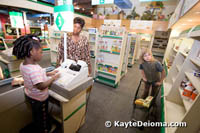 The great thing about exploring children’s museums around the country and around the world is that I get to see how each city puts their own flavor on the play and learn experience. Designed for ages one to eleven, theLouisiana Children’s Museum in New Orleans has some universal favorites like the Kids’ Café where youngsters can cook up pretend food and serve it to their friends or parents. There’s the ever-popular Little Sav-a-Center where kids can shop, run the cash register or stock the shelves. There is also the requisite opportunity to dress up as a fire fighter or police officer and learn about safety issues.
The great thing about exploring children’s museums around the country and around the world is that I get to see how each city puts their own flavor on the play and learn experience. Designed for ages one to eleven, theLouisiana Children’s Museum in New Orleans has some universal favorites like the Kids’ Café where youngsters can cook up pretend food and serve it to their friends or parents. There’s the ever-popular Little Sav-a-Center where kids can shop, run the cash register or stock the shelves. There is also the requisite opportunity to dress up as a fire fighter or police officer and learn about safety issues.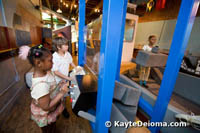 What makes the Louisiana Children’s Museum unique to its home town is the Little Port of New Orleans, where little stevedores can use a gantry crane to load and unload cargo from a barge. Captains can pilot a tow boat down the Mississippi. Ship’s mates can whip up a pretend meal in a cruise ship galley. An interactive wall map lights up to show the different routes that cargo travels to and from the Port of New Orleans.
What makes the Louisiana Children’s Museum unique to its home town is the Little Port of New Orleans, where little stevedores can use a gantry crane to load and unload cargo from a barge. Captains can pilot a tow boat down the Mississippi. Ship’s mates can whip up a pretend meal in a cruise ship galley. An interactive wall map lights up to show the different routes that cargo travels to and from the Port of New Orleans.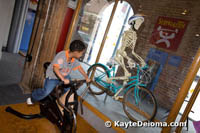 Other exhibits include Body Works, addressing physical fitness and how the body works. You can ride a bike with Mr. Bones, a skeleton that pedals along with you and demonstrates how your bones move when you ride. Measure your height in a magic doorway. Climb a rock wall. Test your balance on the balancing board. Lift 500 pounds with a lever, or lift yourself up with a pulley.
Other exhibits include Body Works, addressing physical fitness and how the body works. You can ride a bike with Mr. Bones, a skeleton that pedals along with you and demonstrates how your bones move when you ride. Measure your height in a magic doorway. Climb a rock wall. Test your balance on the balancing board. Lift 500 pounds with a lever, or lift yourself up with a pulley.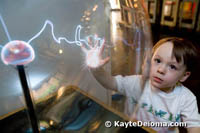
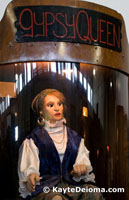 The Musče Mčcanique is a great place to entertain yourself and the kids for a rainy hour or a day depending on how many quarters you’re willing to part with. Even if you’re not a fan of the usual arcade games, you can admire the craftsmanship of the antique mechanical wonders and read up on the history of carnival and beach boardwalk culture.
The Musče Mčcanique is a great place to entertain yourself and the kids for a rainy hour or a day depending on how many quarters you’re willing to part with. Even if you’re not a fan of the usual arcade games, you can admire the craftsmanship of the antique mechanical wonders and read up on the history of carnival and beach boardwalk culture.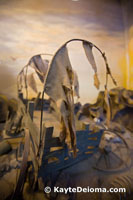 You can have your fortune told by a wizard or a carnival gypsy, have your palm read by the Mystic Ray or let the Kiss-O-Meter tell you just how hot you are in a range from blah to burning to uncontrollable. For a quarter, the Mystic Ray tells me “You are very prudent, never taking a move without lengthy deliberation
”
You can have your fortune told by a wizard or a carnival gypsy, have your palm read by the Mystic Ray or let the Kiss-O-Meter tell you just how hot you are in a range from blah to burning to uncontrollable. For a quarter, the Mystic Ray tells me “You are very prudent, never taking a move without lengthy deliberation
”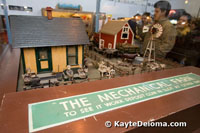 Most of the mechanical tableaus were much grander and had lots of action going on. A carnival scene has hundreds of moveable parts that come to life with the insertion of a few quarters. The Ferris wheel turns; sideshow characters come to life and jungle animals perform. The Unbelievable Mechanical Farm is even more complex with farm animals, a saw mill, hay barn and dozens of characters doing everything from plowing to shoveling coal, from baling hay to reading the newspaper with lots of folks just sitting around chatting.
Most of the mechanical tableaus were much grander and had lots of action going on. A carnival scene has hundreds of moveable parts that come to life with the insertion of a few quarters. The Ferris wheel turns; sideshow characters come to life and jungle animals perform. The Unbelievable Mechanical Farm is even more complex with farm animals, a saw mill, hay barn and dozens of characters doing everything from plowing to shoveling coal, from baling hay to reading the newspaper with lots of folks just sitting around chatting.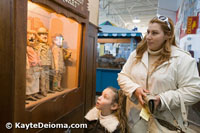 Puppets in glass cases dance, sing and ring bells. A whole array of mechanical instruments and music boxes from the turn of the century play a wide variety of tunes – so many in fact that there are three CDs of tunes played on these instruments available in the gift shop or online. Some are straightforward player pianos, others, like the Orchestrion, include a multitude of instruments within a single case.
Puppets in glass cases dance, sing and ring bells. A whole array of mechanical instruments and music boxes from the turn of the century play a wide variety of tunes – so many in fact that there are three CDs of tunes played on these instruments available in the gift shop or online. Some are straightforward player pianos, others, like the Orchestrion, include a multitude of instruments within a single case.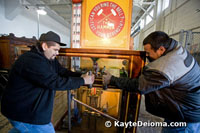 two opponents against each other operating a precursor to Rock’em Sock’em Robots. In the Marathon Cycle Race, two players race bicycles around a vertical track. In Zelinsky’s own 1989 creation, The Hammer, two people can match strength by trying to use a lever to lift a heavy hammer and ring a bell. An Arm Wrestling machine warns of the mechanical arm’s “superhuman strength” and gives you two tries to best the machine for a quarter. There are also more modern games of agility, speed and ingenuity from a Pirates of the Caribbean pinball machine, to early Atari arcade games and Super Chexx table hockey.
two opponents against each other operating a precursor to Rock’em Sock’em Robots. In the Marathon Cycle Race, two players race bicycles around a vertical track. In Zelinsky’s own 1989 creation, The Hammer, two people can match strength by trying to use a lever to lift a heavy hammer and ring a bell. An Arm Wrestling machine warns of the mechanical arm’s “superhuman strength” and gives you two tries to best the machine for a quarter. There are also more modern games of agility, speed and ingenuity from a Pirates of the Caribbean pinball machine, to early Atari arcade games and Super Chexx table hockey.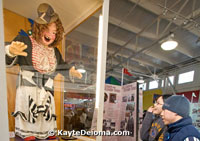 A lot of the machines are too tall for little kids to play easily, but the traditional mechanical horse is always popular and there are step stools around to give the little ones a boost. Some of the machines are definitely PG – especially the giant Laffing Sal and her smaller laughing buddies who have been giving kids nightmares and inspiring horror films for generations.
A lot of the machines are too tall for little kids to play easily, but the traditional mechanical horse is always popular and there are step stools around to give the little ones a boost. Some of the machines are definitely PG – especially the giant Laffing Sal and her smaller laughing buddies who have been giving kids nightmares and inspiring horror films for generations.